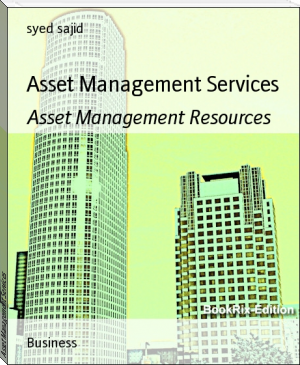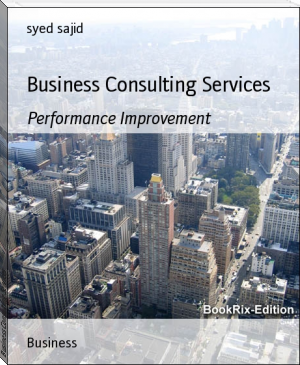Zimbabwe Business Manual 101, Fidelis Fengu [book club recommendations .TXT] 📗

- Author: Fidelis Fengu
Book online «Zimbabwe Business Manual 101, Fidelis Fengu [book club recommendations .TXT] 📗». Author Fidelis Fengu
How do you define your need? Do you need money to expand or as a cushion against risk?
How urgent is your need? You can obtain the best terms when you anticipate your needs rather than looking for money under pressure.
How great are your risks? All businesses carry risks, and the degree of risk will affect cost and available financing alternatives.
In what state of development is the business? Needs are most critical during transitional stages.
For what purposes will the capital be used? Any lender will require that capital be requested for very specific needs.
What is the state of your industry? Depressed, stable, or growth conditions require different approaches to money needs and sources. Businesses that prosper while others are in decline will often receive better funding terms.
Is your business seasonal or cyclical? Seasonal needs for financing generally are short term. Loans advanced for cyclical industries such as construction are designed to support a business through depressed periods.
How strong is your management team? Management is the most important element assessed by money sources.
Perhaps most importantly, how does your need for financing mesh with your business plan? If you don't have a business plan, make writing one your first priority. All capital sources will want to see your plan for the start up and growth of your business.
Not All Money Is the Same
There are two types of financing: equity and debt financing. When looking for money, you must consider your company's debt-to-equity ratio- the relation between dollars you've borrowed and dollars you've invested in your business. The more money owners have invested in their business, the easier it is to attract financing. If your business has a high ratio of equity to debt, you should probably seek debt financing. However, if your company has a high proportion of debt to equity, experts advise that you should increase your ownership capital (equity investment) for additional funds. That way you won't be over-leveraged to the point of jeopardizing your company's survival.
Equity Financing
Most small or growth-stage businesses use limited equity financing. As with debt financing, additional equity often comes from non-professional investors such as friends, relatives, employees, customers, or other people in the tourism industry. However, the most common source of professional equity funding comes from venture capitalists. These are institutional risk takers and may be groups of wealthy individuals, government-assisted sources, or major financial institutions.
Most specialize in one or a few closely related industries.
Different venture capitalists have different approaches to management of the business in which they invest. They generally prefer to influence a business passively, but will react when a business does not perform as expected and may insist on changes in management or strategy. Giving up some of the decision-making and some of the potential for profits are the main disadvantages of equity financing.
Debt Financing
There are many sources for debt financing: banks, savings and loans, and commercial finance companies are the most common. The government has developed many programs in recent years to encourage the growth of small businesses in recognition of their positive effects on the economy. Family members, friends, and former associates are all potential sources, especially when capital requirements are smaller.
Traditionally, banks have been the major source of small business funding. Their principal role has been as a short-term lender offering demand loans, seasonal lines of credit, and single-purpose loans for machinery and equipment. Banks generally have been reluctant to offer long-term loans to small firms.
In addition to equity considerations, lenders commonly require the borrower's personal guarantees in case of default. This ensures that the borrower has a sufficient personal interest at stake to give paramount attention to the business. For most borrowers this is a burden, but also a necessity.
Estimating Costs
In order to determine how much money you will need to start, you must estimate the costs of your business for at least the first several months. Every business is different, and has its own specific cash needs at different stages of development, so there is no universal method for estimating your start up costs. Some businesses can start on a shoestring budget, while others may require considerable investment in inventory or equipment. It is vitally important to know that you will have enough money to start your business.
To determine your startup costs, you must identify all the expenses that your business will incur during its startup phase. Some of these expenses will be one-time costs such as the fee for incorporating your business or price of a sign for your building. Some will be ongoing, such as the cost of utilities, inventory, insurance, etc.
While identifying these costs, decide whether they are essential or optional. A realistic start up budget should only include those things that are necessary to start that business. These essential expenses can then be divided into two separate categories: fixed and variable. Fixed expenses include rent, utilities, administrative costs, and insurance costs. Variable expenses include inventory, shipping and packaging costs, sales commissions, and other costs associated with the direct sale of a product or service.
The most effective way to calculate your start up costs is to use a worksheet that lists all the various categories of costs (both one-time and ongoing) that you will need to estimate before starting your business. The following tool will assist you in performing that task:
Cash Management
Business analysts report that poor management is the main reason for business failure. Poor cash management is probably the reason most businesses do not work. Understanding the basic concepts of cash flow will help you plan for the unforeseen eventualities that nearly every business faces.
Cash vs. Cash Flow
Cash is ready money in the bank or in the business. It is not inventory, it is not accounts receivable (what you are owed), and it is not property. These can potentially be converted to cash, but can't be used to pay suppliers, rent, or employees.
Profit growth does not necessarily mean more cash on hand. Profit is the amount of money you expect to make over a given period of time. Cash is what you must have on hand to keep your business running. Over time, a company's profits are of little value if they are not accompanied by positive net cash flow. You can't spend profit; you can only spend cash.
Cash flow refers to the movement of cash into and out of a business. Watching the cash inflows and outflows is one of the most pressing management tasks for any business. The outflow of cash includes those checks you write each month to pay salaries, suppliers, and creditors. The inflow includes the cash you receive from customers, lenders, and investors.
Positive Cash Flow: If its cash inflow exceeds the outflow, a company has a positive cash flow. A positive cash flow is a good sign of financial health, but by no means the only one.
Negative Cash Flow: If its cash outflow exceeds the inflow, a company has a negative cash flow. Reasons for negative cash flow include too much or obsolete inventory and poor collections on accounts receivable (what your customers owe you). If the company can't borrow additional cash at this point, it may be in serious trouble.
Components of Cash Flow
A Cash Flow Statement shows the sources and uses of cash and is typically divided into three components:
Financing Cash Flow
Investing Cash Flow
Operating Cash Flow
Financing Cash Flow: Financing cash flow is the cash to and from external sources, such as lenders, investors and shareholders. A new loan, the repayment of a loan, the issuance of stock, and the payment of dividend are some of the activities that would be included in this section of the cash flow statement.
Investing Cash Flow: Investing cash flow is generated internally from non-operating activities. This includes investments in plant and equipment or other fixed assets, nonrecurring gains or losses, or other sources and uses of cash outside of normal operations.
Operating Cash Flow: Operating cash flow, often referred to as working capital, is the cash flow generated from internal operations. It comes from sales of the product or service of your business, and because it is generated internally, it is under your control.
How Do I Practice Good Cash Flow Management?
Good cash management is simple. It involves:
Knowing when, where, and how your cash needs will occur
Knowing the best sources for meeting additional cash needs
Being prepared to meet these needs when they occur, by keeping good relationships with bankers and other creditors
Cash Flow Management
The starting point for good cash flow management is developing a cash flow projection, or estimate of how much money will flow through your business. Smart business owners know how to develop both short-term (weekly, monthly) cash flow projections to help them manage daily cash, and longterm (annual, 3-5 year) cash flow projections to help them develop the necessary capital strategy to meet their business needs. They also prepare and use historical cash flow statements to understand how they used money in the past.
Break Even Analysis
Break even analysis is a tool used to determine when a business will be able to cover all its expenses and begin to make a profit. For the startup business it is extremely important to know your startup costs, which provide you with the information you need to generate enough sales revenue to pay the ongoing expenses related to running your business.
A startup business owner must understand that $5,000 of product sales will not cover $5,000 in monthly overhead expenses. The cost of selling $5,000 in retail goods could easily be $3,000 at the wholesale price, so the $5,000 in sales revenue only provides $2,000 in gross profit available for overhead costs. The breakeven point is reached when revenue equals all business costs.
To calculate your breakeven point you will need to identify your fixed and variable costs. Fixed costs are expenses that do not vary with sales volume, such as rent or administrative salaries. These costs have to be paid regardless of sales and are often referred to as overhead costs. Variable costs vary directly with the sales volume, such as the costs of purchasing inventory, shipping, or manufacturing a product.
The formula for determining your breakeven point requires no more than simple mathematics, iyo svomhu yakatizwa ne vamwe kuchikoro..
The next topic is marketing.
BUSINESS MARKETING
Marketing Basics
To succeed in any business, entrepreneurs must attract and retain a growing base of satisfied customers. Marketing programs, though widely varied, are all aimed at convincing people to try out or keep using particular products or services. Business owners should carefully plan their marketing strategies and performance to keep their market presence strong.
What is Marketing?
Marketing is based on the importance of customers to a business and has two important principles:
1. All company policies and activities should be directed toward satisfying customer needs. 2. Making a big profit is more important than having your business earn more money, but with smaller profits.
To best use these principles, a small business should:
Determine the needs of their customers through market research
Analyze their competitive advantages to develop a market strategy
Select specific markets to serve by target marketing
Determine how to satisfy customer needs by identifying a market mix
Market Research
Successful marketing requires accurate market information. An inexpensive research program, based on questionnaires given to current or prospective customers, can often uncover possible new products or services. Market research will also identify trends that affect sales and profitability. Keep population changes, legal developments, and the local economic situation in mind to quickly identify problems and opportunities. It is also important to keep up with competitors' market strategies.
Marketing Strategy
A marketing strategy identifies customer groups, which a particular business can better serve than its target competitors, and fits product offerings, prices, distribution, promotional efforts, and services to these people. Ideally, the strategy should allow you to fill your niche and make money too. A good strategy helps a business focus on the target markets where it can do well.
Target Marketing
Owners of small businesses usually have limited resources to spend on marketing. Concentrating your efforts on one or a few key market areas -





Comments (0)